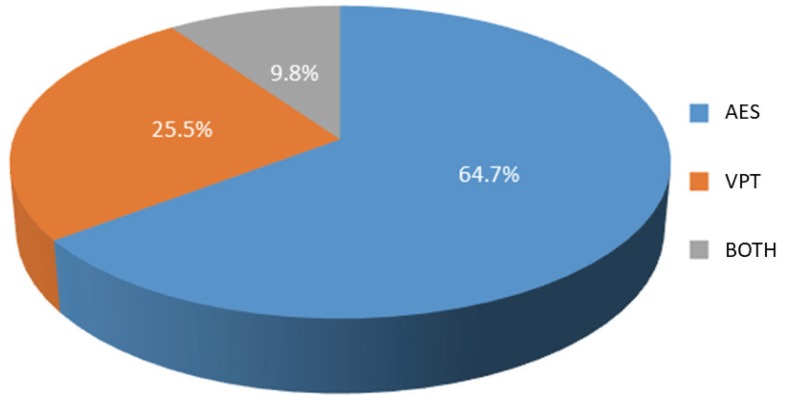J Dent Anesth Pain Med.
2019 Aug;19(4):227-233. 10.17245/jdapm.2019.19.4.227.
Use of an animated emoji scale as a novel tool for anxiety assessment in children
- Affiliations
-
- 1Department of Pediatric and Preventive Dentistry, M.R. Ambedkar Dental College and Hospital, Bengaluru, India. jyothsnavsetty@yahoo.com
- KMID: 2456014
- DOI: http://doi.org/10.17245/jdapm.2019.19.4.227
Abstract
- BACKGROUND
Dental anxiety in children is a major barrier in patient management. If dental anxiety in pediatric patients is assessed during the first visit, it will not only aid in management but also help to identify patients who are in need of special care to deal with their fear. Nowadays, children and adults are highly interested in multimedia and are closely associated with them. Children usually prefer motion pictures on electronic devices than still cartoons on paper. Therefore, this study was conducted to evaluate a newly designed scale, the animated emoji scale (AES), which uses motion emoticons/animojis to assess dental anxiety in children during their first dental visit, and compare it with the Venham picture test (VPT) and facial image scale (FIS).
METHODS
The study included 102 healthy children aged 4-14 years, whose dental anxiety was measured using AES, VPT, and FIS during their first dental visit, and their scale preference was recorded.
RESULTS
The mean anxiety scores measured using AES, FIS, and VPT, represented as mean ± SD, were 1.78 ± 1.19, 1.93 ± 1.23, and 1.51 ± 1.84, respectively. There was significant difference in the mean anxiety scores between the three scales (Friedman test, P < 0.001). The Pearson's correlation test showed a very strong correlation (0.73) between AES and VPT, and a strong correlation between AES and FIS (0.88), and FIS and VPT (0.69), indicating good validity of AES. Maximum number of children (74.5%) preferred AES.
CONCLUSION
The findings of this study suggest that the AES is a novel and child-friendly tool for assessing dental anxiety in children.
MeSH Terms
Figure
Reference
-
1. Kritsidima M, Newton T, Asimakopoulou K. The effects of lavender scent on dental patient anxiety levels: a cluster randomised-controlled trial. Community Dent Oral Epidemiol. 2010; 38:83–87. PMID: 19968674.
Article2. Skaret E, Raadal M, Berg E, Kvale G. Dental anxiety among 18-year-olds in Norway. Prevalence and related factors. Eur J Oral Sci. 1998; 106:835–843. PMID: 9708686.3. Hakeberg M, Berggren U, Gröndahl HG. A radiographic study of dental health in adult patients with dental anxiety. Community Dent Oral Epidemiol. 1993; 21:27–30. PMID: 8432101.
Article4. Buchanan H, Niven N. Validation of a facial image scale to assess child dental anxiety. Int J Paediatr Dent. 2002; 12:47–52. PMID: 11853248.
Article5. Sullivan C, Schneider PE, Musselman RJ, Dummett CO Jr, Gardiner D. The effect of virtual reality during dental treatment on child anxiety and behavior. ASDC J Dent Child. 2000; 67:193–196. PMID: 10902078.6. Sadana G, Grover R, Mehra M, Gupta S, Kaur J, Sadana S. A novel Chotta Bheem–Chutki scale for dental anxiety determination in children. J Int Soc Prev Community Dent. 2016; 6:200–205. PMID: 27382534.7. Corah NL. Development of a dental anxiety scale. J Dent Res. 1969; 48:596. PMID: 5256508.
Article8. Wong HM, Humphris GM, Lee GT. Preliminary validation and reliability of the modified child dental anxiety scale. Psychol Rep. 1998; 83:1179–1186. PMID: 10079713.
Article9. Cuthbert MI, Melamed BG. A screening device: Children at risk for dental fears and management problems. ASDC J Dent Child. 1982; 49:432–436. PMID: 6960031.10. Shetty RM, Khandelwal M, Rath S. RMS Pictorial Scale (RMS-PS): an innovative scale for the assessment of child's dental anxiety. J Indian Soc Pedod Prev Dent. 2015; 33:48–52. PMID: 25572374.
Article11. Alwin N, Murray JJ, Niven N. The effect of children's dental anxiety on the behaviour of a dentist. Int J Paediatr Dent. 1994; 4:19–24. PMID: 7748843.
Article12. Venham LL, Gaulin-Kremer E. A self-report measure of situational anxiety for young children. Pediatr Dent. 1979; 1:91–96. PMID: 399677.13. Locker D, Thomson WM, Poulton R. Onset of and patterns of change in dental anxiety in adolescence and early adulthood: a birth cohort study. Community Dent Health. 2001; 18:99–104. PMID: 11461066.14. Locker D, Liddell A, Dempster L, Shapiro D. Age of onset of dental anxiety. J Dent Res. 1999; 78:790–796. PMID: 10096455.
Article15. Taani DQ, El-Qaderi SS, Abu Alhaija ES. Dental anxiety in children and its relationship to dental caries and gingival condition. Int J Dent Hyg. 2005; 3:83–87. PMID: 16451387.
Article16. Dogan MC, Seydaoglu G, Uguz S, Inanc BY. The effect of age, gender and socio-economic factors on perceived dental anxiety determined by a modified scale in children. Oral Health Prev Dent. 2006; 4:235–241. PMID: 17153645.17. Kleiman MB. Fear of dentists as an inhibiting factor in children's use of dental services. ASDC J Dent Child. 1982; 49:209–213. PMID: 6953082.
- Full Text Links
- Actions
-
Cited
- CITED
-
- Close
- Share
- Similar articles
-
- Effects of Providing Animated Information on Anxiety and the Nursing Satisfaction of Children who have Received Strabismus Surgery and their Guardians
- Use of Animated Cartoons with Children's Songs to Increase Compliance with Ultrasonography in Young Children
- Development of the Korean Version of Fear-Anxiety Survey Schedule for Children
- Sucrose solution for alleviating needle pain during inferior alveolar nerve block in children aged 7–10 years: a randomized clinical trial
- A Study on Uncertainty, Anxiety and Nursing Needs in Mothers of Hospitalized Children





